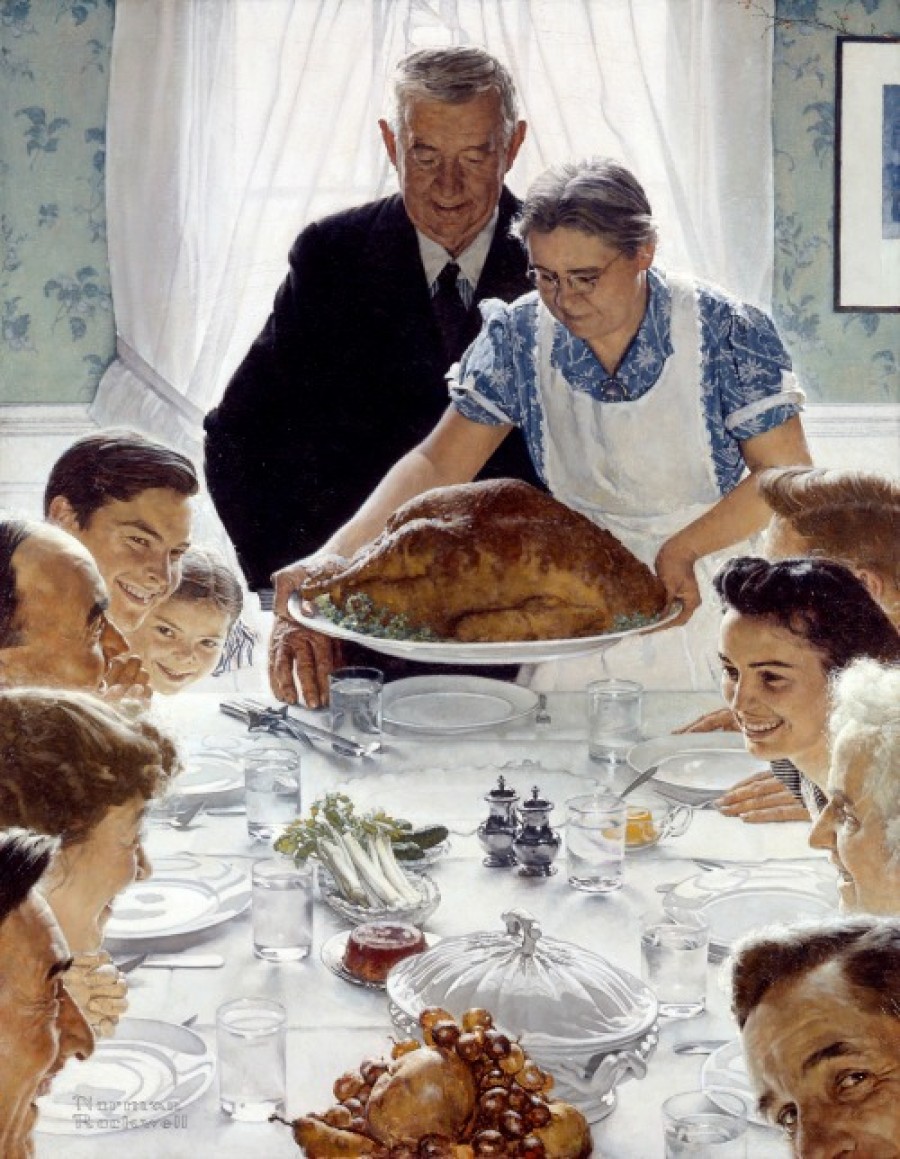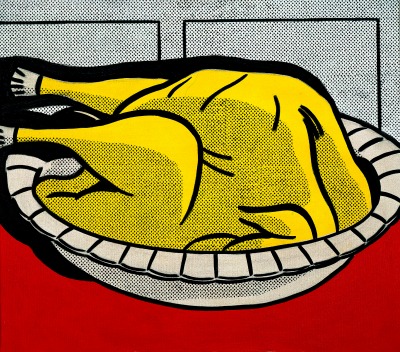Did Norman Rockwell ruin Thanksgiving turkey?
By Monica Eng

Did Norman Rockwell ruin Thanksgiving turkey?
By Monica Eng‘Freedom from Want’
Later this month, millions of Americans will sit down to Thanksgiving dinners of unevenly cooked turkey — dinners that look suspiciously like the one in Norman Rockwell’s “Freedom From Want” painting now on display at the Art Institute of Chicago.
The overcooked white meat will require pools of gravy to choke it down, and undercooked globs of dark meat will get quietly pushed into the garbage (or microwave).
Sure, some cooks have devised strategies around these pitfalls, but with 20 degrees between cooking temperatures for the leg and the breast, it’s a rare bird that comes out perfectly done all the way around.
So who’s to blame for this culinary crime? And why do we endure this ritual torture like another year of Uncle Charlie’s corny jokes?
Looking for answers
John Caveny, who raises Bourbon Red Heritage turkeys on his farm in Monticello, Ill, echoed what many of America’s top chefs have been saying for years: turkeys should not be cooked whole if you want the best tasting bird.
Caveny follows a “Cook’s Illustrated” method of dry brining his turkey parts with three parts kosher salt and one part baking powder, then leaving them covered in plastic wrap for a couple of days in the fridge.
“This allows the moisture, salt and baking powder to go back and forth through the muscle,” he said. “It imparts the flavor of the salt, and the baking powder raises the pH of the meat, tenderizing it a little. It works well, and even better well when you’ve cut turkey into pieces first.”
Similarly, Julia Child famously recommended disassembling the bird and then reconstructing it for the table and chef Grant Achatz recommends breaking it down, cooking the breast, thighs and legs sous vide (a high tech boil in a bag system) and saving the other bits for gravy.
So if top chefs and turkey farmers recommend breaking down the bird first, why do so many of us insist on keeping it whole? Caveny blames the Norman Rockwell painting.
“Prior to that, meat was usually cut up in the kitchen and brought to the table sliced or at least into more manageable portions than a whole turkey,” he said.

I recently took in Rockwell’s famous painting at the Art Institute of Chicago’s new exhibit, “Art and Appetite.” Curator Judith Barter said the one hundred paintings and sculptures in the exhibition are about much more than just food.
“Freedom From Want,” for example, depicts a sense of abundance and security that so many Americans longed for in the post-Depression era. And what better than a whole honking turkey — not some measly platter of slices — to say abundance?
But Barter pushes back on the notion that there weren’t a lot of whole turkey roasters in the years prior to Rockwell’s painting. She said the recipes, texts and paintings she studied for the exhibit indicated that “whole turkeys were common in the 19th century.”
Food historian and Roosevelt University emeritus professor Bruce Kraig generally agreed.
“When turkeys first arrived in Europe in the 16th century, they were cooked whole in various ways,” he said. “Roasting was one of them and boiling was another very popular way. Roasting whole turkeys seems to run right through colonial cookery and the 19th century.”
Kraig points to a page in the first American cookbook, “American Cookery” by Amelia Simmons, published in 1796. The recipe for roasted turkey calls for a stuffing of wheat bread, suet, eggs, sweet marjoram, sweet thyme, pepper, salt and “a gill of wine.” (It also recommends serving the bird with cranberry sauce and mashed potatoes, but also mangoes. Talk about early fusion recipes!)
Breeding a bigger bird
But Kraig points out that turkeys of Simmons’ era were relative waifs compared to their modern chesty cousins.
“The modern broad breasted turkey was bred and crossbred throughout the 19th century with the intention of making them fatter and larger with very big breasts,” he said. “This was in direct response the whole mythic story of turkey at the first Thanksgiving.”
The turkeys got so busty, in fact, that by the time the Broad Breasted White (today’s dominant breed) came along in the late 1940s, it could no longer have sex and could procreate only through artificial insemination.
Despite this lack of fun, the breed grows quickly and produces prodigious amounts of (easily dried out) white meat. Earlier breeds, and indeed heritage birds, grow slower, sport more fat and offer a more even ratio of dark to white meat, thus making them easier to cook evenly.
Breaking from tradition
So it’s not so much Rockwell’s fault, per se. It’s that Rockwell’s painting coincided with a revolution in turkey breeding — one that produced giant breasts that are harder to cook evenly with legs and thighs attached.
Caveny says he can tell by the way the breastbone lies on the bird in Rockwell’s painting that the artist was depicting a heritage bird — not an industrial Broad Breasted White — on his the table. So those who cling to Rockwell’s whole-bird ideal are probably trying to pull it off with a different breed entirely.
Janet Fuller is the former food editor of the Chicago Sun-Times and a current writer for DNAInfo Chicago. A couple of years ago she wrote a story in the Sun-Times urging folks to give up the ghost of the whole turkey for a more edible bird.
She even served the cut-up version at her own Thanksgiving dinner. I asked her, did anybody squawk?
“No,” she said. “It worked great. The leg meat, in particular, was amazing — falling off the bone in the braising liquid, which became my gravy. It is some extra work because you do it in stages, but it was fantastic.”
Monica Eng is a producer at WBEZ and co-host of the food podcast Chewing the Fat. Follow her on Twitter @monicaeng.